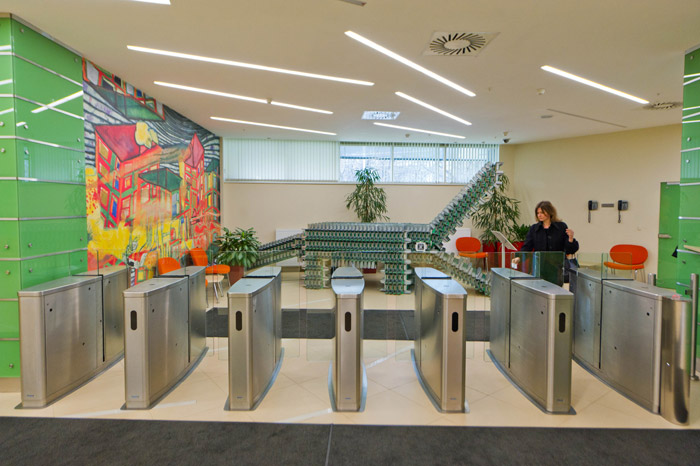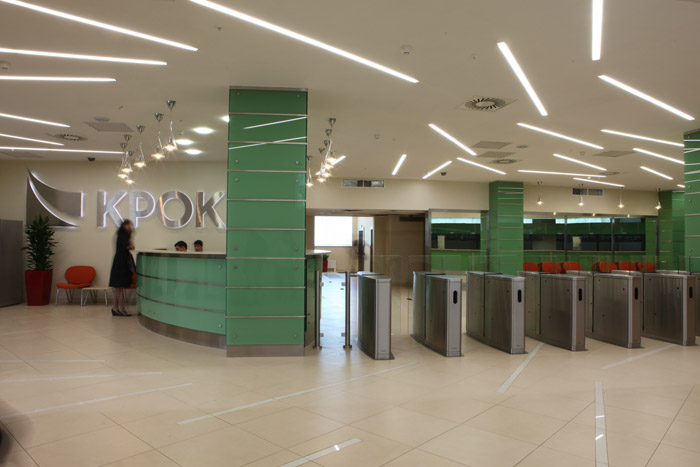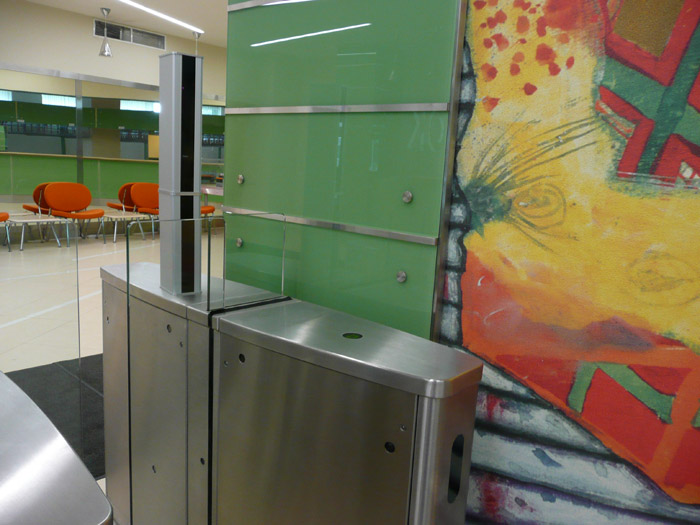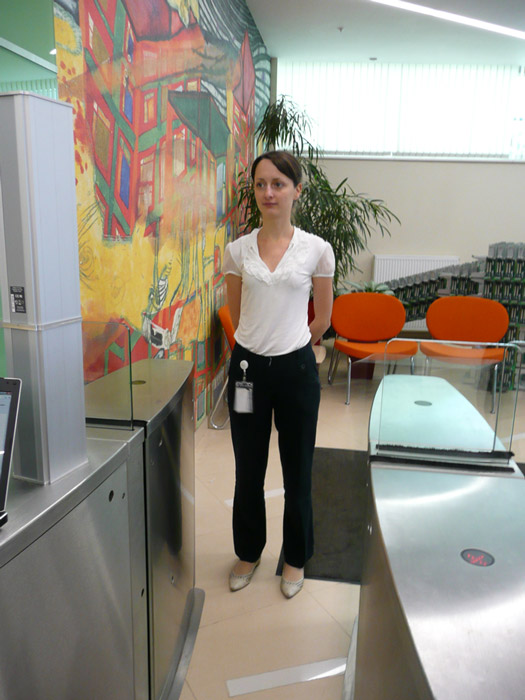But the robot turnstile, which recognizes you in person

So the robot sees you
Turnstiles, memorizing persons , have already been tested in the FSO, the airport of Norilsk and in our office. They recognize you in sunglasses, a hat with earflaps and distinguish you from your twin brother. But let's start from the beginning.
In each system there is an intermediate agent with which reconciliation is underway: it can be a card with a key, a radio key, and so on. This thing creates a lot of problems, because it can be lost, another can pass through it, and so on. Plus, when there are a lot of tenants in the business center, this is generally a real hell with key card formats.
')
It is logical that it is necessary to verify without an intermediate agent, if there is such a technical possibility. Unfortunately, reconciliation of fingerprints (they are always with them) does not provide the necessary accuracy: there are either false positives, or a banal cut, dirt, and so on.
What else does a person have that is quite unique and not particularly subject to change? Face. But the face is changing and changing indistinctly: until recent years, there was a lack of a huge amount of computing power to solve this problem. Now the problem has been solved, and 3D face recognition allows you to use it instead of the key.
Why face is better than fingers?
- Like a finger, you can not swap a face with a mate. It is not lost.
- It does not change. More precisely, it is changing within a certain wide temporary corridor, but far less often than fingerprints, and it has a large number of “reference points”.
- The face is recognized in 3D: this means that even dirt is not a hindrance.
- The face contains more information: there is a reserve for all sorts of scratches, cuts and bruises.
- You can scan without contact.
- Usually, the face is open in advance: the finger must be brought, hands taken out of the pockets, gloves removed, and so on. This is the extra seconds at the checkpoint.
- Old fingerprint scanners can be bypassed with someone else’s finger in your pocket, but with a face this trick will not work.
Checkpoint with a queue
Another thing where face detection is useful is the checkpoint under the “DDoS attack”. This usually happens in large enterprises 5 minutes before the start of a shift. At this moment, a huge number of employees are breaking through the checkpoint, trying to get through as soon as possible. At the same time, someone has strict requirements for the absence of being late for the workplace, someone has changed the card with his mate, as his own is lost, someone just tries to run faster to not wait. With such a flow, the security at the checkpoint does not physically have time to compare the people who are simultaneously running through several turnstiles and photos from the database (if they are displayed at all to the security officer).
The result is usually one - mediocre control, a large amount of falsified information about aisles. Either the control is good, but the lossy employees (as in our office) have to spend extra time in the morning to get a temporary pass for one day. Dissatisfied with either the employee, who, as he thinks, frankly trolls security, or security, which is responsible for people missed on one-time passes.

Employee pass to office
Decision
Once we found out that the employees of one large museum center go to the archives and other specially protected premises without any pass card (I must say, the level of protection there is almost like in the defense industry). We studied the issue, got acquainted with the equipment.
It turned out that one point of passage and control requires the installation of one scanner on a special stand at a strictly defined height. You also need a single computing module that provides all the math of the recognition process. Inside the scanner, a structured backlight device is placed, which imposes an invisible grid on the person’s face.
A high-resolution fixed focal length camera mounted inside the scanner ensures that the overlaid mesh is captured. The brains of this process, placed in the computational module, analyze the data obtained from the camera, take into account all the bends of the light rays, calculate the deviations from the initial coordinate grid and build a vector model from the difference.
When constructing a vector model or a template, the face is divided into segments, each of them is responsible for a part of the face that is more or less significant for the algorithm. For example, the segment in which the nose is located — the most prominent part of the face — always has the largest weighting factor for the algorithm; this is the reference area from which the entire template is built. And the eyes, on the contrary, are not taken into account when building a pattern, the mouth area also has a smaller weight coefficient. Thus, inside a template, a person’s face looks like a “patchwork quilt”: a map with different weights.
"Raw" face is at the very beginning of the topic.
The 3D-template is stored in the computing module, it can be twisted in space, viewed from different sides. This template will later be used for comparison with the person’s face as they pass through the access point (turnstile, door).
With the passage of registered people in the recognition process there can be situations when two people are somewhat similar. They will be similar not only to those people who look at them, but also for the system, which in the process of comparing the template from the base and the person standing in front of the scanner will give the result of a match, for example, 25-35%. With this coincidence value, the system will not miss a person, however, a record will remain in the database stating that someone, like a registered Pyotr Nikolayevich, tried to pass at 9 hours and 47 minutes. Thus, we come to the concept of recognition threshold, that is, the percentage value of the coincidence of the resulting mask and the stored template. By changing this parameter in the system settings, you can reduce or increase the level of security at the protected object.
Tests
To begin with, we decided to try the system right on our own in our rather big office, to a heap full of inventive IT specialists.
The installation requires careful positioning of the device - there are other turnstiles on the left, and we don’t want people passing through the neighboring passageway point of view. Therefore, everything is extinct, we verify, check and, finally, it is clear how the scanner will be installed.
Passing:

Layout of the turnstile cover for the installation of Stella:

The final touch before fixing the base plate we trust, of course, to the neat girl:

And here the scanner is installed:

Employee test pass through the updated access control system:

In the photo, the girl stands only to understand the place where the frame is taken. In practice, you can just go to the turnstile: just look at the camera in the process of quiet movement, and the system will instantly scan and build a person’s face, create a 3D model and compare it with templates from the base.
In our case, the comparison occurs in the identification mode - the model is compared with all templates from the database. However, you can configure the system to work in verification mode, and then an employee’s personal template will be associated with each pass. This will allow to increase the protection mode and speed up the data processing by the access control system.
Shortly after the installation of the system, all those who wished were registered and now may not experience stress, losing time to receive a temporary pass if you forgot it at home. Already more than 450 different people use face identification with us.
As with any new system, you have to get used to this decision. We are different - tall and tiny, gloomy and funny, we come in different weather and with different hairstyles. But the 3D recognition system is not scary. Lovely girls may not be afraid that they will not be missed if they suddenly change their hairstyle, if bangs appear, or if they have not removed their sunglasses when entering the building - the system will still recognize and let in the office. And young people can not worry because of the mustache and beards, which were released or, on the contrary, were set free.
The harsh operating conditions of the solution also withstand: the system has been working for several months at the Norilsk airport, where the climate requires thorough insulation, hats with earflaps and other headgear. But even this does not prevent her from recognizing and letting in aviation security officers.
And the system was tested by FSO officers in the Kremlin, where it was checked how it works with the twins. The system proved to be excellent on the standard recognition threshold - the twin did not miss!
Perhaps it remains to say a few words about the possibility of rapid deployment and the cost of the solution. Even for a short time in a couple of months, we have already managed to take the system to several demonstrations and presentations, including the Innoprom 2012 exhibition. The longest stage of the entire process of deploying a recognition system at the exhibition stand was the flight Moscow-Yekaterinburg. And then it took me 30 minutes to set up a prepared installation site to install a demo stella with a scanner and monitor, connect several cables and make sure that the system came to life and was ready to let in guests who had been registered.

CROC's booth at Innoprom 2012 Bratislava
Cost of
In order to create one full access point with the possibility of identification both at the entrance and at the exit, as well as to provide conditions for the correct and accurate registration of people, it will take about $ 60,000 for the equipment and for installation. The cost of installation is calculated depending on the installation conditions and integration into the existing access control system, or the creation of such a system from scratch.
And finally, returning to the original tasks, it is clear that the system is suitable for administrative, office and business centers, where the diversity of tenant access cards will not affect the ease of passage, because we always have our faces with us. Tenants do not incur additional costs, and the process of registering new employees by the security service of an office building will take literally seconds.
At industrial enterprises with a recognition system, the management company can be sure that the passing worker Stepan Nikolaevich is really Stepan Nikolaevich, and the venerable honored designer of the plant may not be afraid to forget the card, and he will not have to pay a fine for being late for work (as it would be if strict guard sent home for a pass).
Well, our employees are satisfied that in the fast-paced race from home to work, they do not have to look for a pass in the depths of immense handbags and weighty portfolios with gadgets.
PS Update topic: there were many questions in the comments on the algorithm. Let me explain why there are few details and what are the limitations of the system.
Historically, the company-developer of this solution was engaged in the development of 3D-scanners for architectural and museum values with a view to the subsequent reconstruction of the model on a 3D printer. And in this field of application, very precise template creation is required, that is, for about 8 years, developers have improved and improved their algorithms in the field of 3D scanning. Then the idea arose to apply developments in the field of biometric recognition, and several more years followed, during which the algorithm underwent a number of approaches and changes in the grid overlay method and the method of processing the data obtained as a result of scanning.
Since there is a high resolution camera in the system, and the location of the person in front of the scanner still needs to be limited, otherwise the scanner installed on one turnstile will start to capture people from the neighboring turnstile, the camera also works only in a fixed person location corridor. Already this necessary restriction imposes a restriction on the illumination of a person’s face - it should not be overexposed, so we come to limit the system’s work only indoors with the desired constant illumination. The following limitation of the work of the system concerns the openness of the face by at least 65-75%, that is, a closed face with a mask where only eyes are visible does not fit. This person will not miss the system. Another limitation concerns too active mimicry - to grimace and smile from ear to ear at the time of recognition will not work. A person should maintain a neutral-calm facial expression, a slight smile is permissible.
As for an even more detailed description of the algorithm, it is, as you understand, closed data of the developer company.
Source: https://habr.com/ru/post/151680/
All Articles